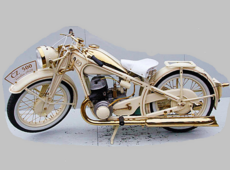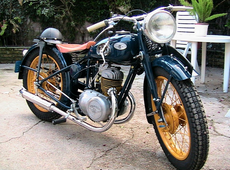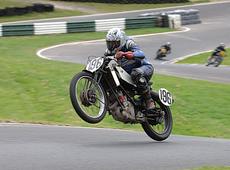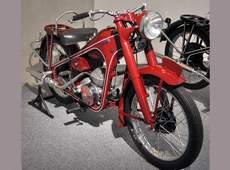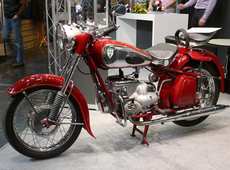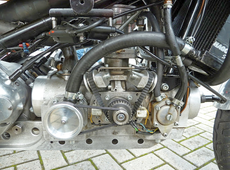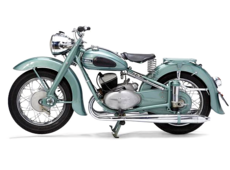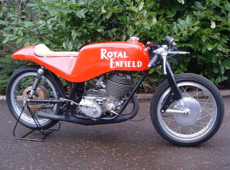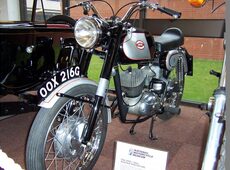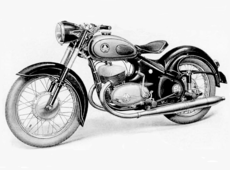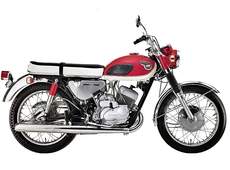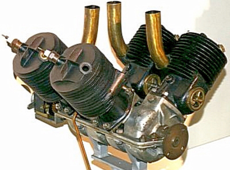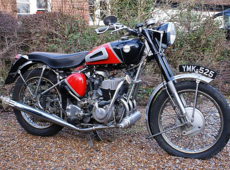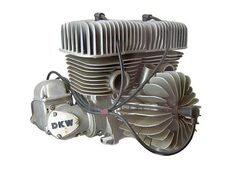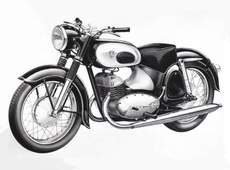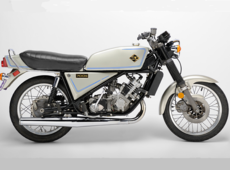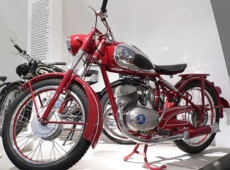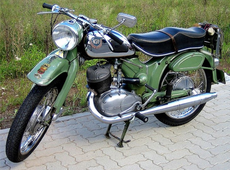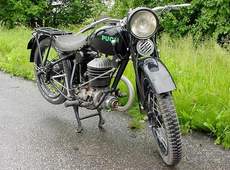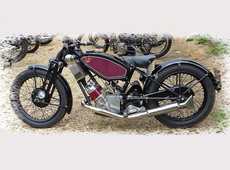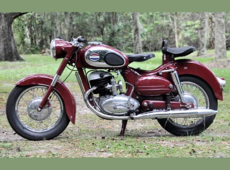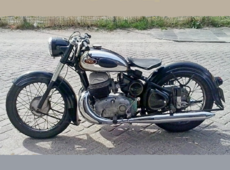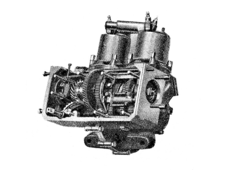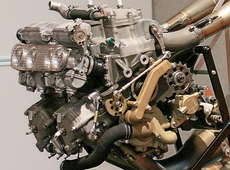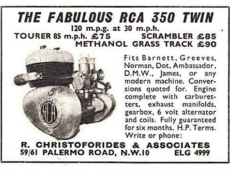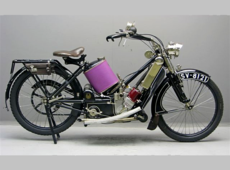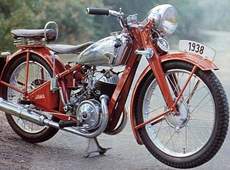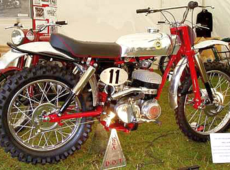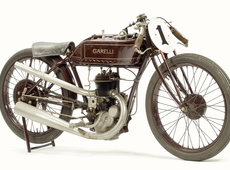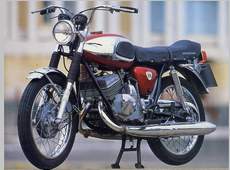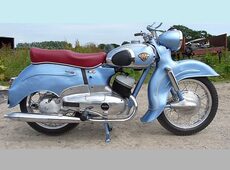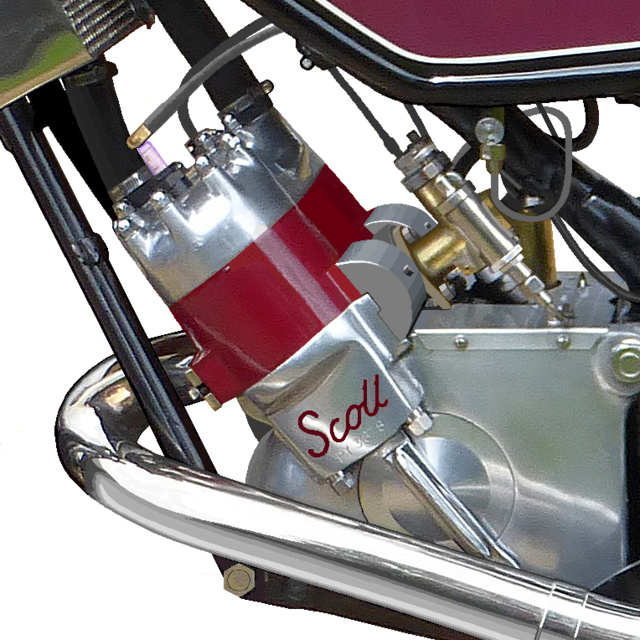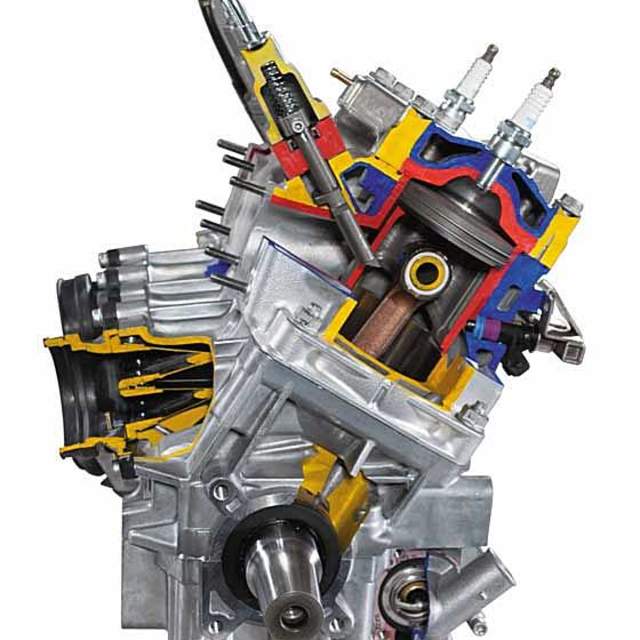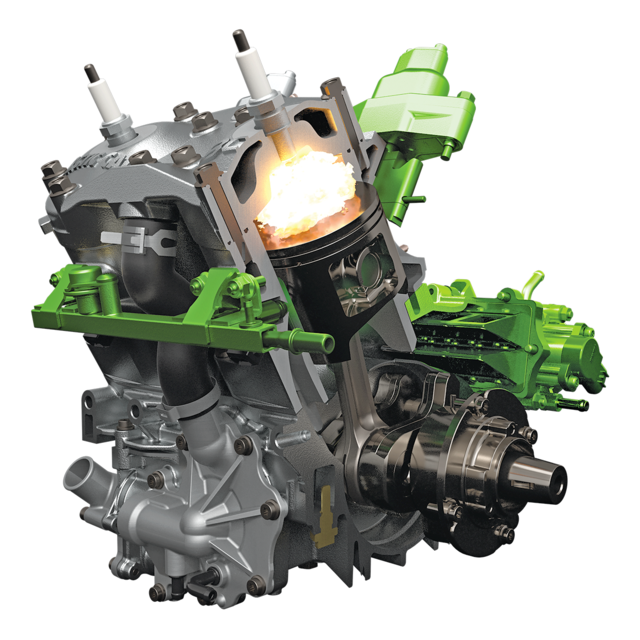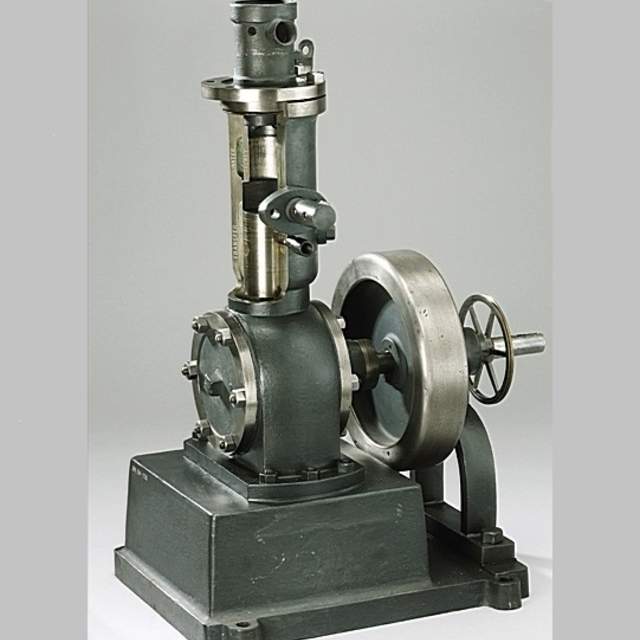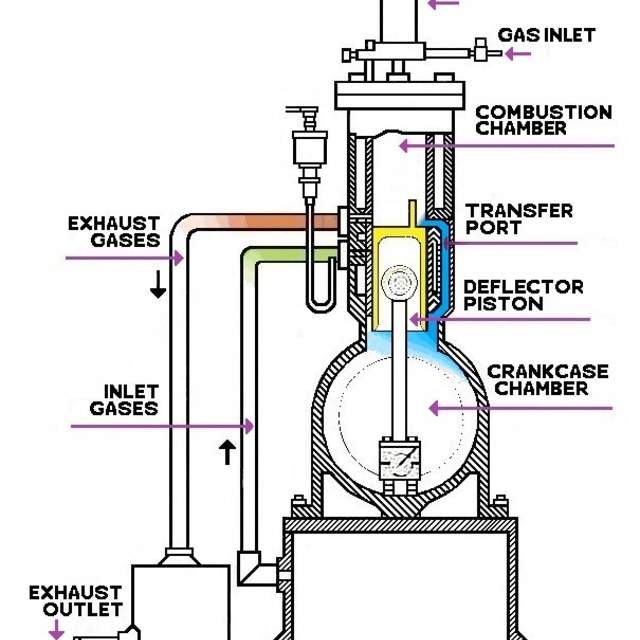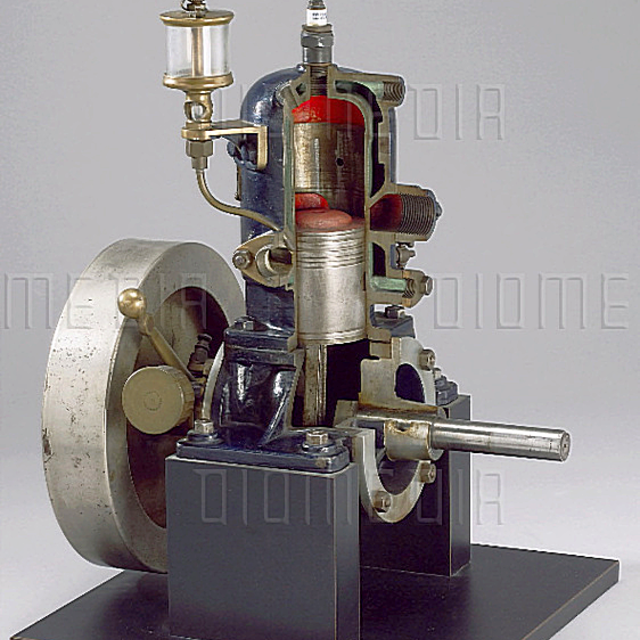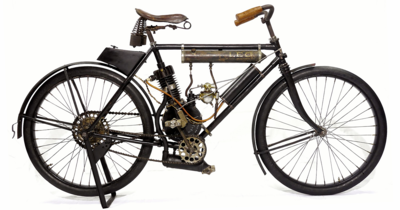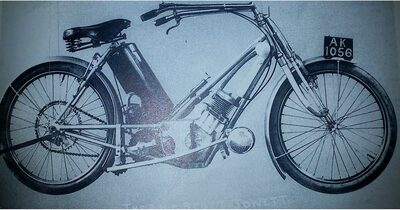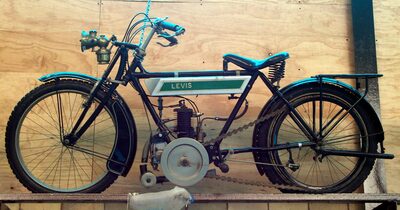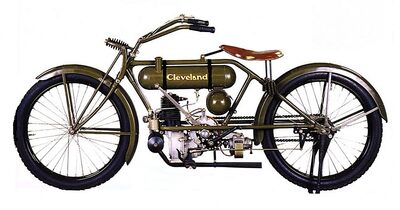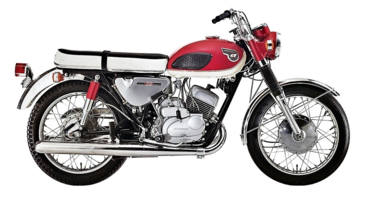
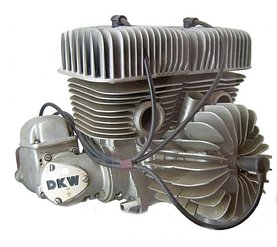
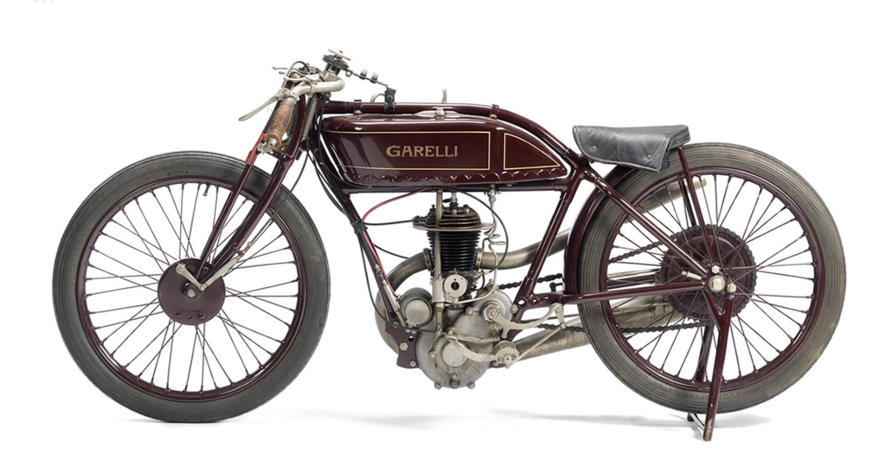
This evolving website was last updated on 05/08/2020 and this page was last updated on 14/01/2019.
Two-stroke motorcycle history
Significant two-stroke motorcycle engines, two-stroke engine development, my thoughts and observations.
Introduction.
I have always had a strong interest in two-stroke engines and because of that I started to write a book on the subject, an effort to find out who really did what, when and where and particularly as the inventor of the two-stroke engine was an Englishman.
The old saying that there is nothing new under the sun is absolutely true, to come up with a totally new idea is rare. New inventions are invariably influenced from another source or application.
From the information I have gathered I thought It might be a good idea to share some of my findings and thoughts on a website, another reason to do this is because I am past my prime and I might not manage to finish the book.
I have also included some personal and non-related motorcycle stuff.
My information has come from books, extreme internet research, accumulated knowledge and personal contacts.
One particular useful source has been from a rather unsavoury German individual named Gerald Frederic Töben, he had a basic website with a complete rundown of nearly all the German motorcycles and there are a lot, his site was not always accurate but still extremely useful. Unfortunately his website is no more, shame.
Töben born 1944 is an infamous German-born Australian citizen, an author on education, political science, history and founder and former director of the Adelaide Institute. He became best known for his holocaust denial, claiming he cannot deny that which never happened. He has served two jail sentences, one in Germany for defaming the dead and one in Australia for breaching a court order to refrain from publishing material on his website vilifying Jews.
Despite his qualifications and outspoken opinions he also found time to pursue his other interest, German motorcycles. Not surprisingly his motorcycle website was full of anti British and anti American remarks and constant jibes proclaiming the Germans were blameless etc. Google him yourself and find out for more about this controversial individual.
The Beginnings.
Before the start of the internal combustion engine we had the external combustion engine - the steam engine, I am not a steam engine expert but inevitably engineering features were carried over to feature in early internal combustion engines, an easy example of this is the overhung crank found in the Scott Flying Squirrel.
A quick check shows the first patented steam engine was in 1606, so there were hundreds of years and a stream of hidden engine secrets waiting to be adapted for the internal combustion engine, another good example of steam influence is the French Gerard steam engine of 1906 and it's rotary disc valve.
The application of the rotary inlet disc valve in the two-stroke engine is seen as a relatively modern invention and really coming to the fore in the 1950’s, however this is not the case as it's motorcycle origins are clearly much earlier, particularly as I have access to an old book that was published in 1923, it shows that the British manufacturer Sun Motorcycles produced motorcycles from around 1920 with their own disc valve engines.
In 1889 the Englishman Joseph Day built his first two-stroke engine and three years later in 1892 the final version was built and patented, now including a very significant porting modification by Frederick Cock, a worker at the Day factory.
The exact principles of the Day/Cock engine are still in use to this very day, however it was the Germans who capitalised the most on this very simple design, and it was the Germans who became the major player in two-stroke development and motorcycle production, going on to produce a range of different two-stroke engine configurations and capacities all the way up to 600cc and even above.
Because of economic difficulties prior to and after the First World War meant that Germany was in a recovery situation, and it was only in the early 1920’s that volume motorcycle production started. It is very noticeable that many of the German companies initially produced motorcycles using British four-stroke engines, JAP engines were very popular, however as German two-stoke technology developed it was goodbye British four-stokes and hello German two-strokes.
When doing this research for the inventor of the modern day two-stroke engine you find understandably a whole can of worms of developers and inventors making various claims.
The following is a Quote from an article by a German writer, understandably from a German point of view:-
Interestingly Carl Benz chose to begin with a two-stroke engine as early as 1879 but was quite different from what we call a two-stroke today, containing sliding valves and other mechanical parts. The early four-stroke DeDion-Buton singles were among the first dependable and frequently used motorcycles engines, they were licensed for production by many manufacturers around the world.
A single-source influence is not so easily identified for the two-strokes, there were British, French, Italian and other makers all developing early two-strokes. In Germany it was Julius Söhnlein, from Wiesbaden-Schierstein, who designed a stationary two-stroke engine that used the crankcase for pre-compression as early as 1873. Julius’s brother Heinrich Wilhelm Söhnlein opened a factory to fabricate these engines and his technology influenced two-stroke development in Germany more than any other company, * so piston port two–strokes were used in motorcycles as we know them today were used in motorcycles and present in Germany since about 1902, their breakthrough however was mostly delayed until the 1920s.
End of quote
* As already mentioned, it is Frederick Cock in 1892, a workman for Joseph Day who is credited with the invention of the piston port inlet control in 1892.
Whether it was Nikolaus Otto and his four-stroke or Joseph Day and his two-stroke I suspect that both of them may have used ideas from other sources, probably par for the course in those days, a particularly buoyant period of ideas, designs and theories, for instance there was already a design for a stationary two-stroke engine that used the crankcase for pre-compression as early as 1873.
It’s all very well designing an engine, to prove the design it has to be constructed and run successfully and patented, and it was
the Englishmen Joseph Day who did just that and is recognised as the inventor of the modern day two-stroke engine.
Day’s engine wasn’t specifically designed for motorcycle use, however before 1912 some 60,000 engines were built and sold under license in the USA and some did find there way into motorcycles, however it was for boats where they were the most popular.
The Day engine led to many engineers, mostly from Europe to choose to build their own two-stroke engines for their own motorcycles or for supplying to other budding motorcycle manufacturers.
From 1860 onwards various Locomotive Acts were introduced.
The 1861 Act imposed a speed limit of 10 mph and in 1865 the notorious Red Flag Act was introduced with a speed limit of 4 mph. This act was responsible for having a person walking and waving a red flag in front of any motorised vehicle, the later 1878 Act made the red flag optional under local regulation. It was these restrictive Acts that was responsible for reducing any incentive to produce vehicles with engines while other countries were vigorously continuing development. In 1896 restrictions were relaxed with a new Act.
Many people think the only reason for the use of two-strokes is there reduced manufacturing costs, but this is not entirely the case. The idea of an engine with only three moving parts is very attractive to engineers and manufacturers, especially if these three parts, the piston, connecting rod and crankshaft, can theoretically double the power of the more complex four-stroke engine.
Two-strokes were ill thought of in the first decade of the century, largely because of the inefficient combustion as a result of poor scavenging and the 10-1 petroil mixture used at the time, this caused excessive smoking, fouled sparkplugs and even with 10-1 petroil mixture seizures were not uncommon.
The main reason for this unsatisfactory situation was not because two-stroke engines were basically bad, it’s just that oil, metallurgy and two-stroke technology was in it’s infancy, particular scavenging which was a huge mystery.
At that time the two-stroke cycle for engines was regarded by many theorists and designers as not having any future, and was declared a dead duck well before 1910. Fortunately two-strokes went on to flourish for many years, however current legislation has dampened two-stroke production somewhat, hopefully two-strokes will re-emerge and flourish again in the mass market.
I
there are some truly exciting and amazing two-stroke developments in progress that outperform four-strokes in every way. In fact these new generation engines are already available in some quarters and very successfully as well, they can be found in outboards, snowmobiles and in other situations where engines are used.
Two-stroke engine developments.
Julius Söhnlein 1873 Germany. Designed a stationary two-stroke engine using crankcase pre-compression.
Karl Benz 1879 Germany. Patented a two-stroke gas engine. Benz is more famously known for designing and building his own four-stroke engine, developed in 1885 and patented in 1886, the first four-stroke engined automobiles in production.
Sir Dugald Clerk 1881 Scotland. Inventor and builder of the first two-stroke engine using valves and a compressor.
Edward Butler 1884 England. Constructed the first petrol internal combustion engine (four-stroke). Butler invented the spark plug, ignition magneto, coil ignition and spray jet carburettor, and was the first to use the word petrol
Joseph Day 1889 England. Constructed his first crankcase compression two-stroke gas engine.
Joseph Day 1889 England. Crankcase induction by use of a flap valve.
Joseph Day/Frederick Cock 1892 England. It was Frederick Cock's ground breaking piston port invention that resulted in Joseph Day's final version of his engine, the forerunner of today's two-stroke.
Alfred Scott 1900 England. Alfred constructed his first engine for boats, he had been using his brother’s designed two-stroke engine to drive machinery in his workshop and was impressed by it’s reliability and excellent service.
Alfred Scott 1904 England. Made a complete motorcycle, 450cc two-stroke twin-cylinder engine, triangulated frame 1904.
Alfred Scott 1906 England. A basic 2.5hp single was offered for one year called the Scout, rigid forks and belt drive.
Alfred Scott 1908 England. Manufactured a complete motorcycle, 333cc air cooled, two-stroke vertical twin-cylinder engine.
Alfred Scott 1909 England. Manufactured a very advanced motorcycle, 486cc water cooled, two-stroke vertical twin engine.
Garelli Motorcycles 1912 Italy. Split-single engine.
Sun Motorcycles 1921 England. Rotary inlet valve.
Adolph Schnurle 1925 Germany. Loop scavenging.
Grazer Motorenwerke 1927 Austria. Reed inlet valve.
DKW Motorcycles 1930 Germany. Supercharging.
Zundapp Motorcycles 1934 Germany. Boost port.
Scott Motors 1939 England. Boost port Scott PA stationary engine, credited to Scott's chief engineer William Cull.
DKW Motorcycles 1952 Germany. Expansion chambers.
Yamaha Motorcycles 1967 Japan. Crankcase labyrinth seal.
Yamaha Motorcycles 1968 Japan. 5 port torque induction.
Yamaha Motorcycles 1971 Japan. 7 port torque induction.
Yamaha Motorcycles 1977 Japan. Exhaust power valve.
Honda Motorcycles 1996 Japan. Active radical ignition.
The inventors.
Sir Dugald Clerk, Scotland. 1854-1932.
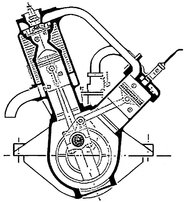 The inventor of the first successful two-stroke (two-cycle) engine was the Scottish engineer Sir Dugald Clerk in 1878 and patented in England in 1881.
The inventor of the first successful two-stroke (two-cycle) engine was the Scottish engineer Sir Dugald Clerk in 1878 and patented in England in 1881.
Clerk’s engine was not the type of two-stroke engine that we know today, this is because the Clerk two-cycle engine used valves like a four-stroke and required a compressor to blow air into the cylinder.
Some very fine Clerk two-cycle engines were made by the Detroit Diesel Company but they were for ships, big trucks or locomotives, however they never made an impact on the mass market.
Joseph Mary Day, England. 1855-1946.
Frederick William Caswell Cock. England. 1863-1944.
The inventors of the modern day two-stroke engine.
The men.
I created Family Trees for both Joseph and Frederick, courtesy of Ancestry, creating Family Trees is always helpful and often very interesting, often giving a clearer incite into what these individuals were really like. 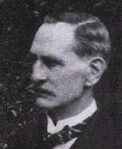
Joseph Mary Day was born on the 27th of September 1855 at 14 Albert Terrace, Bayswater, London, he died on Christmas day 25th December 1946 at St Margaret's-on-Thames, London aged 91. Readers might query Mary as his second name, it does come from 2 trusted sources.
Joseph was the son of Sir John Charles Frederick Sigismund Day 1826–1908, one of the first Catholic judges in England to be appointed after the English Reformation, Joseph's mother was Rose Henrietta Mary Brown 1824 – 1893.
It looks like Joseph started life with a silver spoon in his mouth as his father Sir John was a judge and obviously well off. The censuses show that over a large number of years he was fortunate enough to be able to employ three or four servants, and when Joseph’s father Sir John died in 1908, the probate records show he left effects to the tune of the tidy sum in those days of £102,886 pounds, 15 shillings and 5 pence, phew! Between 1868 and 1873 Joseph Day attended the Beaumont College Catholic School in Windsor and trained as an engineer from 1873-74 at the School of Practical Engineering at Crystal Palace in London, and after his training he worked at Stothert and Pitt in Bath 1874-77.
In 1878 aged just 23 and together with J W Lampard they started an iron foundry engineering company in the Victoria Ironworks, Bath, manufacturing mobile hand cranes, mortar mills, compressors, mechanized bread making and high level waterworks for the City of Bath, most of his work coming from his former employer.
On May 10th 1879 at Midford Castle near Bath he married Margaret Anne Parfitt 1853–1933 eventually producing nine children in all and in 1881 and aged 25 he is now living at Wells Road, Bath, with his wife Margaret aged 27 with two children and two servants.
In 1885 Day was advertising portable hand cranes, mortar mills and Valveless Air Compressors by Day and English, Engineers and Iron Founders, a few years later he advertised a new design of Valveless Air Compressor made under license from the patentee, Edmund Edwards.
In 1888 he is a Director of the newly formed Western Counties Steam Bakeries and Milling Co and in 1891 he is living at 14 North Parade, Bath, aged 35 with wife his Margaret and now has six children and four servants.
In November 1892 an investigation into the directors behaviour leading to the liquidation of the Western Counties Steam Bakeries business.
On September 1893 Day is declared bankrupt.
In February 1894 chairman Joseph Day is questioned about cheques drawn on the company for the Bath and Bristol Steamboat Co. Allegations against Joseph Day and Frank William Lucy about publishing false information about the company, Day is away in America and has been advised to return.
In May 1894 the works and stock of the business is auctioned. 1894 June, verdict returned of 'not guilty'.
The first American patent was taken out in 1894 and by 1906 a dozen American companies had taken out licenses. One of these companies was Palmers of Connecticut and produced over 60,000 two-stroke engines before 1912. Many of these early engines found their way into motorcycles or for powering boats.
1898 Involved in legal action against the Millbury Engineering Co and the Valveless Gas Engine Syndicate regarding the 1892 patent rights on the engine he had sold them. He claimed it was only for the first gas powered version of the engine and not for the later oil type which he had developed some years after the 1892 patent.
1901 Living at 1 Paragon Villas, Weston-Super-Mare with wife Margaret and two daughters, three sons and three servants and working on his own account as a Civil Engineer.
1905 October. Formed the Day Inventions Co in New Jersey USA with his cousin Thomas Fleming Day (1861-1927).
1906 Discharged from bankruptcy and opened Day Motor Co, an engine making business at Barking and then later at Putney.
Much of his money came from the manufacture of bread making machinery, and the prices of wheat were very turbulent around the turn of the Century. The profitability of Day’s factory fluctuated just as wildly. These were early days for the idea of the limited company, and shareholders, then as now, could panic and bring down a company that they thought to be under threat. The problem was made worse by the publication of rumours, or the deliberate orchestration of publicity campaigns in the press.
A flurry of lawsuits followed, with Day as both plaintiff and defendant. The Treasury Solicitor even tried to have him extradited from the USA where he had gone to try to sell his US patents in order to raise money. The case was eventually settled when the jury found that Day had no case to answer, but it all came too late, and he went into virtual retirement by the seaside. The development of his engine then passed to his license holders in America, whose royalties restored his finances sufficiently to allow him to launch a spectacular new venture after the First World War.
Convinced that petrol was the power source of the future he joined the board of English Oilfields and invested in a new enterprise for the exploration for oil in shale at Norfolk. This was an unsuccessful venture and he resigned in 1923, his second financial disaster.
Joseph Day’s engine was initially recorded as a failure by the 18th International Commission the History of Technology Symposium, it is their duty to record any failed innovations, it would appear it failed because of an incredibly complex sequence of issues involving markets, the law, finance and publicity and also may have come about because of personal animosity towards Day, simply because he was a Catholic and living in the city of Bath, a city long famous for it’s negative attitudes towards industrial activity.
Six years after his death in 1946 the London Science Museum appealed for any biographical data about Joseph Day, which they termed as, “the supposed inventor of the crankcase-compression engine," their appeal drew no response whatsoever!
Another appeal but this time by the journal of Engineering journal asking for a portrait photograph and again any biographical details of Joseph Day, who "in 1891 invented the crankcase-compression type of two-stroke internal-combustion engine," but again without success.
We can see from the above that Joseph had his finger in many pies, maybe dodgy pies at times though, I have to wonder however that as his father was a judge did he bail him out at times, or maybe have some influence over decisions concerning Joseph’s possible misdemeanours? For instance, the investigation into the directors behaviour leading to a liquidation, questioned about cheques drawn, publishing false information and involved in legal action against the Millbury Engineering Co. It would appear that Joseph wasn't out to make millions from his sideline of making engines, he was however trying to make his millions in other opportunities.
Joseph did manage to emulate his judge father by having a constant team of servants, unfortunately however he couldn’t emulate his father when it came to keeping hold of his money, his probate records show that he only left £150 and 5 shillings, unlike father Sir John who in 1908 left over £100,000.00 in his. Unbelievably despite Joseph Day's historic achievements he had ended in total obscurity and finally in an Epsom nursing home.
Frederick Cock was born in October 1863, Somerset, England and died in June 1944 in Dartford, Kent, the son of Nathaniel Cock 1839 – 1884 and Martha Newton 1842–1881.
The earlier census’s show he was a Somerset man and married Ada Alberts in 1887, he sired three sons and a daughter and living in Bath near the Joseph Day premises. The 1891 census shows he is still in Bath but the 1901 census show that he is now living and working in London. The 1911 census show that Frederick is still in London and now Joseph Day is also in London and both are shown as mechanical engineers, it’s unclear if Cock is again working for Day, we can only guess.
Unfortunately little else is known about Frederick, apart from him being a workman at the Day concern, a tragedy considering the importance of his contribution to the Day engine.
The engine.
Joseph Day chose to develop an alternative system to the four-stroke engine and set about developing his own two-stroke internal combustion engine, a design that would not conflict with the ever constant litigation in England over the four-cycle patent of Nicholas Otto, the inventor of the first practical four-stroke engine, patented 1886 cancelled 1890.
To protect his interests Otto made it impossible for anyone else to use his ‘the Otto cycle’ system without first obtaining a licence, however it was found that there had already been similar patents registered in Switzerland and France, and following several rulings between 1886 and 1889 by the German Courts eventually resulted in the Otto patent eventually being cancelled. This caused ten years of delay in which the release of the four-stroke engine was blocked by legal proceedings in Germany.
This increased interest in the two-stroke engine as an alternative source of power.
In 1889 Joseph Day built his first two-stroke engine. There were two flap valves in this original design, one in the piston crown which allowed the compressed mixture from the crankcase up through the piston crown and into the combustion chamber for ignition. The other flap valve controlled the inlet port situated in the crankcase, probably where you would find a reed valve on a modern two-stroke engine.
Flap valves were used because the idea of a transfer port didn’t evolve until a couple of years later.
The patent application for the above two-port two-stroke engine was made in April 1891 and was for the crank-chamber to use crankcase compression to charge the firing cylinder by way of the already mentioned piston flap valve.
The patent also covered a version for the removal of the piston crown flap valve, instead a port (transfer port) in the cylinder wall was used, best described as a tunnel in the wall of the cylinder barrel this allowed the pre-compressed mixture up through the transfer ports and into the combustion chamber for ignition. Patent granted in June 1892.
Day made about 250 of these first two-port motors, fitting them to small generating sets and in 1892 his engine won a prize at the International Electrical Exhibition.
On 15 October 1892 Frederick William Caswell Cock a workman at the Day Gas Engine Company in Bath applied to patent his highly significant improvement to the two-port Day engine. A new inlet port was introduced in the cylinder wall, which by the up and down movement of the piston allowed the skirt of the piston to uncover and cover the inlet port, thus allowing the mixture to enter the crankcase pumping chamber. This modification allowed the crankcase inlet port and flap valve to be dispensed with altogether, thus producing a completely valveless engine.
The result, the more efficient and simple Day/Cock three port two-stroke engine, just three moving parts, the simplest form of internal combustion engine, the classic piston ported two-stroke.
Although the patent application was made by Frederick, the patent however was assigned to Joseph Day making him the legal owner and Cock the recognised inventor. Day would have paid for the patent as costs may have been a problem for workman Cock.
In 1894 the first American patent was taken out by Day and by 1906 a dozen American companies had taken out licenses.
Some engines found there way into motorcycles but boats was the most popular application for the Day/Cock engine, over 60,000 engines were built and sold in the US before 1912.
The scavenging system that Joseph Day used on his deflector piston engine is known as cross scavenging and was the norm for two-stroke engines, until the general adoption of Adolph Schnürle’s more efficient flat top piston loop scavenging invention of 1925. The Schnurle system became the system to use and is now common place everywhere.
To give Day his due there has been a resurgence of the deflector piston cross scavenging system with fresh development with engines being manufactured using this system.
In 1900 Alfred Scott produced his first two-stroke engine, used and tested in boats.
In an article in Motor Cycle magazine in 1914, Alfred Scott wrote that he was drawn to the two-stroke engine because he was trained on high speed steam and marine engines, and when turning his attention to gas and petrol engines the regular power strokes of the two-stroke (or the Day cycle as he sometimes called it), seemed preferable to the one power stroke in four of the Otto cycle. He said this attraction to the two stroke was further enhanced by the reliable and excellent service from a two stroke engine designed by his brother (A. F. Scott M.I.M.E) and used to drive machinery in his experimental workshop.
There appears to be only two photographs of Day engines in existence, the gas engine of 1891-1892 shown below and a petrol engine of 1913.
Click a picture for the slideshow.
The first complete production two-stroke motorcycles.
To find the very first production two-stroke motorcycle offered for sale is nigh impossible, maybe because these dirty smelly things weren’t taken seriously at first and maybe history didn’t think they were worth recording.
I’m not concerned with pedal cycles with an engine lobbed in, such as Alfred Scott’s first Premier pedal cycle in 1901 with the engine in front of the headstock and behind the headstock in 1902. The attractive 1905 Leo from California is great example of an engine within a cycle frame, see pictures at the bottom of this page.
Wherever and whenever these early two-stroke engines became available it is well known that many found their way into boats, although a more difficult task a few also found their way into bicycles, there must have been quite a few of these bicycles with engines made that were never documented.
For me the first proper motorcycle that can truly be regarded as a motorcycle is one that is not an adapted pedal assisted cycle frame, it should have a frame specifically constructed to support the engine and petrol tank etc. and that several motorcycles should be available for the public to purchase.
To start producing the first proper two-stroke motorcycles for sale takes some commitment and belief but sadly historic records are rather short on this subject. One of the contenders for the first production two-stroke motorcycles could be the Scott Scout of 1906 however information is very sparse on this device, however my efforts to find the first production two-stroke motorcycle is still in progress. Another contender is Germany’s Hans Grade, born in Koslin Pomerania 1879 - 1946, who in 1905 developed a 331cc motorcycle two-stroke engine 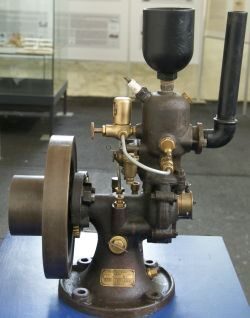 and later in the same year supplied a batch of these engines for Fritz Burckhardt of Magdeburg. Fritz had a bicycle business and decided to expand into selling his Burckhardtia branded motorcycles, it is not clear whether his first motorcycle was an actual motorcycle or just a engine in a cycle frame, I suspect the latter at the start of his venture bearing in mind Fritz sold bicycles.
and later in the same year supplied a batch of these engines for Fritz Burckhardt of Magdeburg. Fritz had a bicycle business and decided to expand into selling his Burckhardtia branded motorcycles, it is not clear whether his first motorcycle was an actual motorcycle or just a engine in a cycle frame, I suspect the latter at the start of his venture bearing in mind Fritz sold bicycles.
Grade's 331cc motorcycle engine production ended in 1908 when his main customer Fritz Burckhard closed the motorcycle side of his business because of poor sales and as a result Hans Grade ceased motorcycle engine manufacture in late 1908. As Burckhardt main business was pedal cycles I suspect his motorcycles were just cycle frames with an engine stuck in. Sadly their aren't any pictures of this early device. Further development of the Grade two-stroke motorcycle engine would have to wait for the better times of the 1920s.
Hans was a pioneering German aviator specialising in 2 stroke engine aircraft. On 28 October 1908 he successfully conducted the first motor-flight over German soil in a motorised triplane aircraft of his own construction at Magdeburg and year later on 30 October 1909, he flew a new monoplane of his own design and won the 40.000 Reichsmark "Lanz-Preis der Lufte". The prize for being the first German to fly a flat "8" in a German aircraft with German engine around two pylons 1000 meters apart.
In 1910 he established the first aviation school in Germany.

